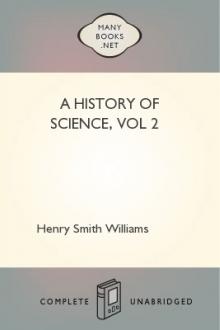Genre - Science. You are on the page - 3

was any sudden change in the level of mentality of the Roman world at the close of the classical period. We must assume, then, that the direction in which the great minds turned was for some reason changed. Newton is said to have alleged that he made his discoveries by "intending" his mind in a certain direction continuously. It is probable that the same explanation may be given of almost every great scientific discovery. Anaxagoras could not have thought out the theory of the moon's

Ptolemy succeeded in devising a scheme by which the apparent changes that take place in the heavens could, so far as he knew them, be explained by certain combinations of circular movement. This seemed to reconcile so completely the scheme of things celestial with the geometrical instincts which pointed to the circle as the type of perfect movement, that we can hardly wonder Ptolemy's theory met with the astonishing success that attended it. We shall, therefore, set forth with sufficient detail

oration and study of these antiquities is stated as follows: "Although possessing throughout certain general points of resemblance going to establish a kindred origin, these works nevertheless resolve themselves into three grand geographical divisions, which present in many respects striking contrasts, yet so gradually merge into each other that it is impossible to determine where one series terminates and another begins." On the upper lakes, and to a certain extent in Michigan, Iowa,

The skeleton is made up of many different parts, each of which is called a bone.3. The bones are covered by the flesh. 4. The bones of the head form the skull, which is hollow and contains the brain. 5. A row of bones arranged in the back, one above another, forms the backbone. The backbone has a canal running through it lengthwise, in which lies the spinal cord. 6. The trunk is hollow, and has two chambers, one called the cavity of the chest, and the other the cavity of the abdomen. 7. The

years ago, a distinguishedbiologist wrote in the Frankfurter Zeitung that it would secureimmortality for its author, the most notable critic of the idea ofimmortality. And the Daily Telegraph reviewer described the Englishversion as a "handsome edition of Haeckel's monumental work," and "anissue worthy of the subject and the author."The influence of such a work, one of the most constructive thatHaeckel has ever written, should extend to more than the few hundredreaders who

ctor, whether one looks from one eye to the other, or from some more distant object to one's own eyes, the eyes may be seen now in one position and now in another, but never in motion." This phenomenon was described by Graefe,[6] who believed it was to be explained in the same way as the illusion which one experiences in a railway coach when another train is moving parallel with the coach in which one sits, in the same direction and at the same speed. The second train, of course, appears